Category: What's New?
- Home
- /
- Shop
- /
- Newest Resources
- /
- What's New?
- /
- Page 7
Showing 121–140 of 384 resultsSorted by latest
-
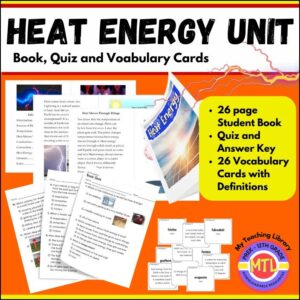 $3.25Buy Now
$3.25Buy NowThis unit introduces several important concepts about heat energy including heat sources, temperature measurement, controlling heat through insulation and the importance of heat energy for living things. This unit will also explain how heat is transferred including convection, conduction and radiation.
The resource includes:
- – Student book
- – Quiz with answer key
- – Vocabulary cards with definitions
-
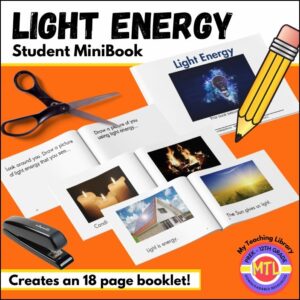 $1.75Buy Now
$1.75Buy NowStudents will create an 18 page mini-book as they learn about different sources of light energy!
-
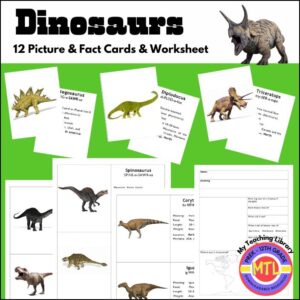 $2.50Buy Now
$2.50Buy NowStudying dinosaurs? Here are 12 picture and fact cards plus a worksheet for students to use as the report on each dinosaur!
Dinosaurs included: Spinosaurus, Ankylosaurus, Stegosaurus, Pteranodon, Velociraptor, Triceratops, Corythosaurus, Iguanodon, Diplodocus, Dimetrodon (not a true dinosaur but often covered in textbooks), Apatosaurus, Tyrannosaurus. -
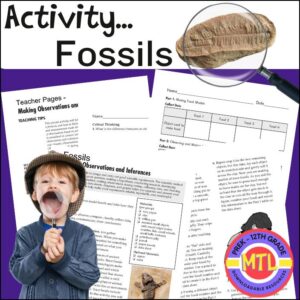 $1.25Buy Now
$1.25Buy NowStudying fossils? With this fun activity, students will create a variety of ‘fossils’ while learning how to make observations, inferences and how to distinguish between the two!
Includes- Student and teacher pages:
– Student “how to” activity pages
– Student data worksheet
– Student critical thinking worksheet
– Teacher pages and answer keys -
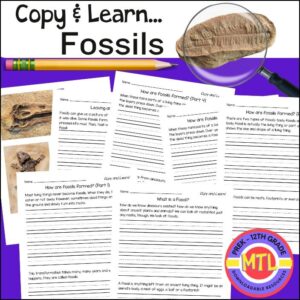 $1.75Buy Now
$1.75Buy NowThis elementary resource is designed to teach students about fossils. In this ‘Copy and Learn’ product, students will learn what fossils are made of, two types of fossils (body and trace) and how they form.
Included: 6 Copy and Learn pages and 1 fossils photo page. -
 $2.00Buy Now
$2.00Buy NowIn this resource, students will learn about living things, (plants and animals) and what they need to survive within their habitats. Students will investigate the dependence of plants on air, water, nutrients, and light. They will also learn about pollination and how many plants depend on animals for pollination and the dispersal of seeds. Students will learn about various animal habitats and how some animals change with the seasons.
This resource includes both student and teacher materials.
Number of Lessons – Depending on how you divide up and teach lesson segments, there will be 12 to 20 lessons of 30-45 minutes each. Science video links are included in the teacher materials.
-
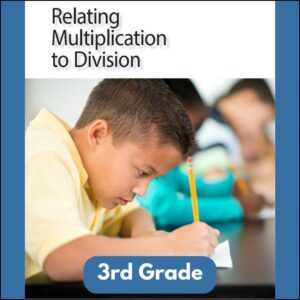 $2.00Buy Now
$2.00Buy NowThis unit introduces students to the concept of division and its relationship to multiplication. Previously, students learned that multiplication can be understood in terms of equal-size groups. The expression 5 x 2 can represent the total number of objects when there are 5 groups of 2 objects, or when there are 2 groups of 5 objects. Here, students make sense of division also in terms of equal-size groups. For instance, the expression 30 ÷ 5 can represent putting 30 objects into 5 equal groups or putting 30 objects into groups of 5. They see that, in general, dividing can mean finding the size of each group, or finding the number of equal groups. Students use the relationship between multiplication and division to develop fluency with single-digit multiplication and division facts.
This resource includes both student and teacher materials.
Number of Lessons: 21 and 1 optional
Lesson Time: Approximately 60 minutes. Please note that each lesson is designed for one instructional block and may be divided into shorter or longer segments based on teacher pacing and student needs.
-
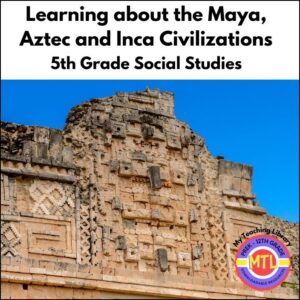 $2.00Buy Now
$2.00Buy NowThis unit is designed to teach students about three ancient Mesoamerican civilizations, Maya, Aztec and Inca, in a geographic context. They will explore ruins of Mayan temples and pyramids, learn about the warrior culture of the Aztecs and the city of Tenochtitlan as well as the complex network of roads and cities of the Inca civilization.
Number of Lessons: 10
This unit is over 200 pages and includes both student and teacher materials!
Watch a short product preview. -
 $2.00Buy Now
$2.00Buy NowThis unit on Lakes of the World is designed to teach students about the benefits and resources provided by lakes throughout the world while reviewing important map skills and geographical terms. Students will learn about the following lakes:
– In Asia: the Caspian and Aral Seas
– In Africa: Lake Victoria, Tanganyika and Chad
– In South America: Lakes Maracaibo and Titicaca
– In Morth America: the Great LakesThis resource includes both student and teacher editions.
Watch short preview video. -
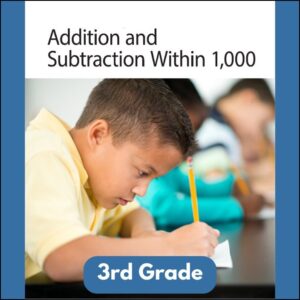 $2.00Buy Now
$2.00Buy NowIn this unit, student work toward the goal of fluently adding and subtracting within 1,000. They will use mental strategies as well as learn algorithms based on place value. By the end of this unit, students will also use rounding to estimate answers to two-step problems and determine if answers are reasonable.
This resource includes both student and teacher materials.
Number of Lessons: 20 and 1 optional
Lesson Time: Approximately 60 minutes. Please note that each lesson is designed for one instructional block, and may be divided into shorter or longer segments based on teacher pacing and student needs.See description below for more details.
-
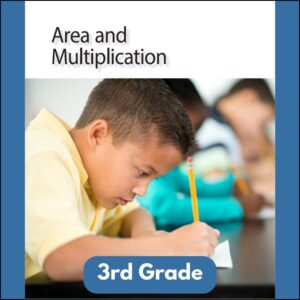 $2.00Buy Now
$2.00Buy NowThis unit is designed to build on unit 1 as student explore the concept of area and relate the area of rectangles to multiplication as well as solving area problems. Students also learn some standard unit of area such as square inches, square centimeters, square feet and square meters as they solve real-world problems! By the end of the unit, students find the area and missing side lengths of figures composed on non-overlapping rectangles.
This resource includes both student and teacher materials.
Number of Lessons: 13 and 2 optional
Lesson Time: Approximately 60 minutes. Please note that each lesson is designed for one instructional block, and may be divided into shorter or longer segments based on teacher pacing and student needs.
View a short preview video hereSee description below for more details.
-
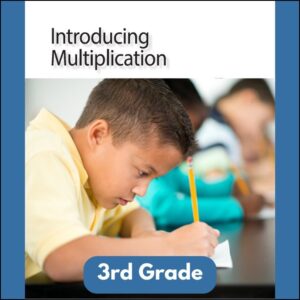 $2.00Buy Now
$2.00Buy NowThis unit is designed to help students learn multiplication by gaining an understanding through the use of picture and bar graphs. Material is presented so that students learn multiplication means finding the total number of objects in groups of objects and can be represented by a x b. Students will work with arrays to learn and understand multiplication expressions before beginning to write the equations. By the end of the unit, problems with a missing factor offers the student a preview to division.
This resource includes both student and teacher materials.
Number of Lessons: 20 and 1 optional
Lesson Time: Approximately 60 minutes. Please note that each lesson is designed for one instructional block, and may be divided into shorter or longer segments based on teacher pacing and student needs.
View a short preview video hereSee description below for more details.
-
 $5.00Buy Now
$5.00Buy NowThis Physics textbook was written in 1920 and will help students gain a solid understanding of the subject matter. It is 436 page .pdf and includes valuable illustrations that will aid in student understanding. There are no test or answer keys, however each chapter will ask important questions and includes a review outline. Because there are no answer keys, it is suggested that students keep a physics science notebook. Within that notebook, they are to
– write out the exercises
– write their answers
– highlight their answers/or text that helped them develop their answers within the textbook
– notate by their answers the page number(s) of highlighted sectionsPreview a small selection of this resource here.
See description below for further details
-
Sale!
 Buy Now
Buy Now$13.50Original price was: $13.50.$9.99Current price is: $9.99.This resource is a BUNDLED product of the following:
Combined, these three .pdf books have over 1400 pages of world literature for High School Students.
Part 1 – The Ancient World includes selections from the Middle East, Near East Greece, China, India and Rome
Part 2 – The Middle Ages includes selections from Europe, the Middle East, China, Japan and South Asia
Part 3 – The Renaissance includes sections from Korea, Europe and Native AmericaSee description below for additional information!
-
 $4.00Buy Now
$4.00Buy NowWorld Literature Part 3 is a 379 page .pdf book of compiled literature from around the world.
Part 1 is entitled: The Renaissance and includes:
Korea:
– Sijo Poetry
– The Tale of Hong Gil-Dong
From Europe:
– Don Quixote
– Gargantua and Pantagruel
– Hamlet
– The Journals of Christopher Columbus
– The Prince
– The Tempest
– Utopia
From Native America:
– Myths of the Cherokee
– Aw-aw-tam Indian Nights: The Myths and Legends of the Pimas
– Of Cannibals
– Popol VuhSee description below for additional information!
-
 $4.50Buy Now
$4.50Buy NowWorld Literature Part 2 is a 517 page .pdf book of compiled literature from around the world.
Part 1 is entitled: The Middle Ages and includes:
Europe:
–The Sermon on the Mount (Matthew 5-7)
– The Parliament of Birds and The Canterbury Tales
– The Decameron
– The Divine Comedy: Inferno
– The Song of Roland
– The Lais of Marie de France
– Lancelot, the Knight of the Cart
– The song of the Cid
– The Travel of Marco Polo
From the Middle East:
– The Rose Garden (Golestan or Gulistan)
– The Quran
– Divani Shamsi Tabriz and Masnavi
– Shahnameh
– The Thousand and One Nights
– Autobiography of Usamah Ibn Munqidh
From China:
– Selected Poems
– The Romance of the Three Kingdoms
From Japan:
– Noh Plays
– Pillow Book
– The Tale of Genji
From South Asia:
– Tukaram’s Selected PoemsSee description below for additional information!
-
 $5.00Buy Now
$5.00Buy NowWorld Literature Part 1 is a 661 page .pdf book of compiled literature from around the world.
Part 1 is entitled: Ancient World and includes:
From the Middle East, Near East Greece:
– “Genesis” and “Exodus” of the Hebrew Bible
– The Epic of Gilgamesh
– The Iliad and The Odyssey
– Medea
– Oedipus the King
– The Apology of Socrates
From China:
– The Analects
– The Art of War
– The Book of Songs
– The Mother of Mencius
– The Zhuangzi
From India:
– The Bhagavad Gita
– The Mahabharata
– The Ramayana
From Rome:
– The Aeneid
– MetamorphosesSee description below for additional information!
View a short video of an excerpt from the text
-
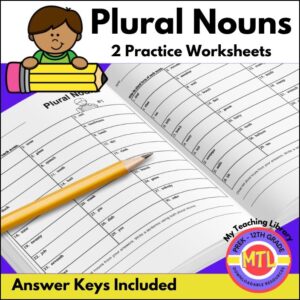 $1.50Buy Now
$1.50Buy NowTwo worksheets that will give students practice changing singular nouns to plural nouns. Each worksheet has 30 nouns to change, plus students are asked to choose two of the new plural nouns to use within a sentence.
Related resources:
-
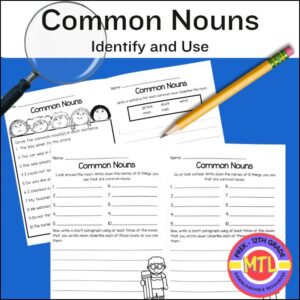 $1.75Buy Now
$1.75Buy NowA group of four worksheets designed for students to practice identifying and using common nouns.
Related resources:
– Noun Classroom Poster Set
– 93 Dolch Common Noun Sight Words -
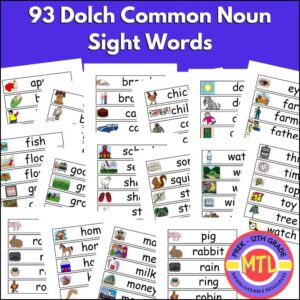 $2.25Buy Now
$2.25Buy NowGive students a list of over 90 common nouns that are Dolch sight words with this resource! Ideas for use:
- Create a word wall
- Display in a writing center
- Place words in a box and have students draw out a given number of words and use within their writing
- Have students create a quick, reference booklet to study and use when writing
- Use as spelling words for several weeks
- Give students several words (cut out) and have them place in alphabetical order
- Ask students to use these common nouns to create proper nouns

